MICHELLE: So, in our last installment of Let’s Get Visual we celebrated the pretty, so it seems only fitting that this time we devote our attentions to images that make us shudder with a feeling I like to call “the jibblies.” Just like beauty, creepy is a subjective thing, so we’ve each chosen a variety of images that get our personal hackles rising.
MJ, you want to go first this time?
MJ: Sure!
So, as I was perusing my manga collection for things that creep me out, it became increasingly clear to me that I’m very simple when it comes to what scares me. All it takes to really get to me is a single disturbing image—especially one that distorts something human into something sinister. I’m apparently not scared of monsters so much as I am of monsters in human clothing.
My first example comes from Setona Mizushiro’s After School Nightmare. In this series, a group of teenagers is regularly drawn into a shared dreamworld in which they each appear as physical manifestations of their own worst fears. Some of these are visually more disturbing than others. The series’ main character, Ichijo, for instance, most fears his own confusion about gender, so his skirt-wearing dream self is really horrifying only to him. Some of the other students, however, wear their fears in a much more visually distorted manner. This short spread features two of those students.
After School Nightmare, Vol. 1 (Go! Comi)

First, you’ll see a student who appears only as an arm and hand, twisting itself around Ichijo. Second, a girl appears with giant cavities replacing her face and chest. While the second of these has the most stunning, immediate affect on my psyche, the first creeps up on me as I try to move away from the page. Both images stick with me long after I’ve put the book down, and this seems to be the real key to scaring the bejeezus out of me. If I can’t get the image out of my mind, it easily haunts me for days. That’s the power of a single, shocking image.
MICHELLE: My first thought upon hearing of your aversion to “a single disturbing image” is that you shouldn’t read Junji Ito’s Uzumaki, followed by the thought that you should read it.
My reaction to the image above differs from yours, though, in that while these images certainly provoke in me an “ew” reaction, they aren’t the type that haunt me. I definitely think that the slinky arm creature is the more creepy in the image you displayed. For me, it’s because the gaping images of emptiness are immediately recognizable as symbols for what that character is feeling, but what on earth is causing that other student to appear like a grasping, creeping arm?! I feel like their circumstances in life might ultimately be the more disturbing! (This comes from someone who’s read only one volume of After School Nightmare, so I don’t know if this turns out to be the case.)
MJ: I think part of what makes the gaping holes in the second student so horrifying for me, is that (for whatever reason) I’m strongly affected by a lack of face. I have the same reaction to images of people with blank faces. It creeps the hell out of me when I can’t assess a person’s feelings/personality from their expression. It feels very threatening to me.
Perhaps it’s further evidence of how much a face means to me, actually, that both of my follow-up images are pretty much face-only. First, from CLAMP’s Tokyo Babylon, we have the face of a dead child who pleads with her mother to avenge her, and secondly, from Jun Mochizuki’s Pandora Hearts, the face of a girl that reveals itself to be a monster underneath.
Tokyo Babylon, Vol. 4 (TOKYOPOP)
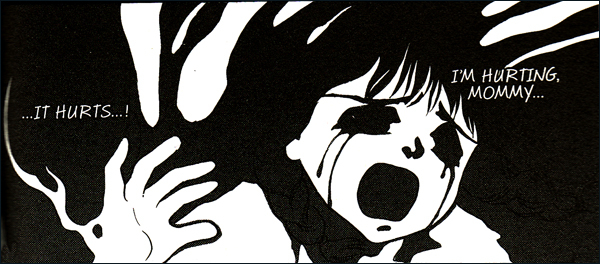
Pandora Hearts, Vol. 1 (Yen Press)

I actually find both of these to be creepier than the images from After School Nightmare, though they are much simpler. Something they have in common is that they are presented against a stark, black background, giving the distorted expressions full focus. After that, though, they are nearly opposites of each other. The face of the girl in Tokyo Babylon is all too real, distorted by the power of raw emotion, while the character in Pandora Hearts is revealed to have no emotion at all, or at least none that matched what was on her false human face. Yet in the end, which is more monstrous?
MICHELLE: It’s interesting how much the things that creep us out reveal about us, isn’t it? I’d wager you get the same threatening feeling from the girl who is revealed to be a monster underneath as you do the girl with no face at all. People pretending to be what they’re not, hiding their real selves, etc. That’s definitely something all of us have experienced at one time or another.
Getting back to actual attempts at visual analysis, those deep black backgrounds really do focus the reader’s eye on what the mangaka wants them to see. It’s as if they’re saying, “I don’t want you to be distracted by anything else.”
MJ: Your analysis of me is spot-on, that’s for sure!
And yes, I think the black backgrounds achieve exactly that, while also evoking our natural fear of the dark, or what we can’t see. It’s a powerful tool for both showing us something and not showing us something, if that makes sense.
MICHELLE: It definitely does.
Now I’m reflecting on what the images I’ve chosen say about me. There’s hardly a face among them, for one thing, because I am less creeped out by shocking images than I am by imagining an experience, specifically an experience during which one is forced to endure something horrible for a really, really long period of time with no means of escape. Ugh, just thinking about the short story my images come from—”The Enigma of Amigara Fault” by Junji Ito—has given me the jibblies while typing this paragraph!
Gyo, Volume 2, “The Enigma of Amigara Fault” (VIZ Media)
I’ve chosen this particular sequence of images from this short story because they illustrate the entire plot without me needing to introduce it beforehand. By now you probably don’t need me to explain that when the TV news reports on a mountainside full of people-shaped holes revealed by a recent earthquake, people flock to the site and can’t be dissuaded from climbing into their personal holes, where long, icky agony awaits them. At first the site seems innocent enough, if a bit strange, but soon people are walking into holes, having nightmares about what happens to you in a hole, and eventually discovering the exit and…. Holy crap, it’s terrifying. This is the kind of thing that will haunt me for ages.
I’m honestly trying to analyze Ito’s artistic techniques dispassionately here, but I find that the disturbing power of the images is so great that it is affecting my ability to reason even now!
MJ: Hmmm, I’m wondering if what it’s saying is that while I’m terrified of people betraying me, you’re terrified of your environment betraying you. Or something like that.
In any case, these panels are undeniably creepy. Even if they creep me out in a less personal way, I can certainly see what’s giving you the jibblies! Interestingly, we again see the human form distorted, though in this case it’s happening sort of *to* the character we’re relating to rather than in front of him. (Maybe I’m afraid of the people I trust being compromised, and you’re afraid of yourself being compromised?)
This has a Twilight Zone feel to me, where some unexplained supernatural phenomenon is turning the lives of ordinary people into a nightmare. The artist does a great job of evoking the real terror of what’s happening, too. The texture of the stone walls around the man gives the images a three-dimensional look that makes it feel more real than a lot of what we see in manga. It’s the only thing that has that kind of thick texture, too, so it really stands out.
MICHELLE: More like I’m terrified of taking a step that can’t be undone and ending up in eternal torment because of it!
And yes, now that I’ve regained my senses, I agree that it’s the realistic three-dimensional detail that really makes it so disturbing. The details of the setting itself establish it firmly in the here and now, and then we’re shown that within the here and now exists something completely alien and unexplainable! Regarding the texture of the stone walls… it’s that bit of dialogue about how they’re carved to prevent backtracking that really gets to me. It’s mute, immobile stone, and it’s going to be your tormentor for the next several months, slowly inflicting more gruesome horrors upon you than something living could ever do. Uh-oh… jibblies.
MJ: There, there!
MICHELLE: Thanks. I also really love the bottom left panel on page 185, when you see the outside world from inside the tunnel. Interestingly, this is an angle from which the guy who just entered the hole could never have seen the characters. He’s got his back turned to this world, and is resolutely leaving it behind. And, too, I love the “less is more” approach here. We don’t see the distorted figure actually emerge from the mountain and thrash around terrorizing people. One glimpse is enough to confirm what has happened. It’s almost kind of elegant in its structure.
MJ: Yeah, I agree, the threat of what is about to happen is actually scarier by itself than it might be if we actually saw it happen. Or at least it’s creepier that way.
MICHELLE: Well, I fear this column has actually been more about us than the art, but it’s been the art that made us feel that way, and that’s something, isn’t it?
MJ: It is!
MICHELLE: So, that’s it for us this month. What gives you the jibblies?

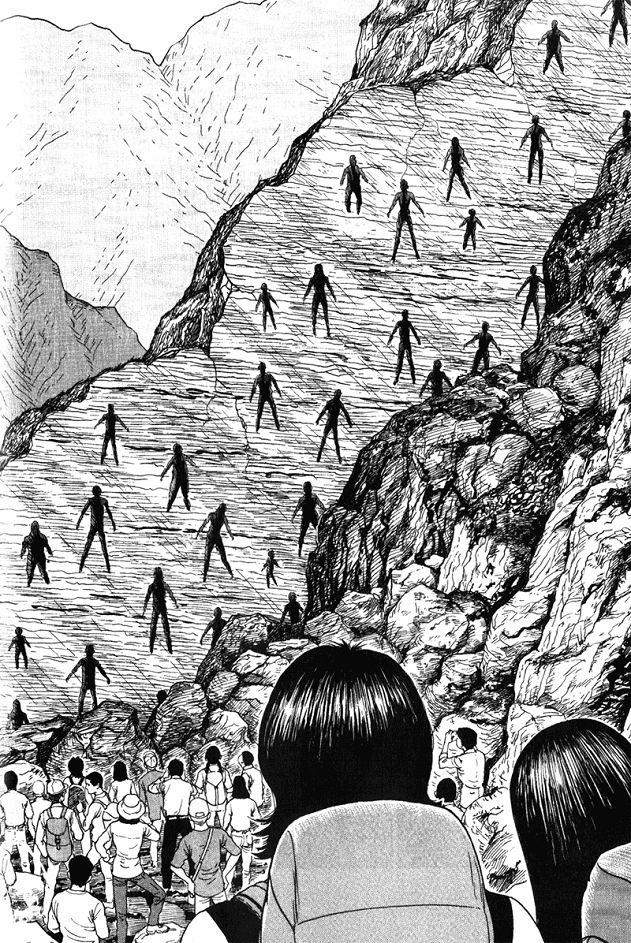
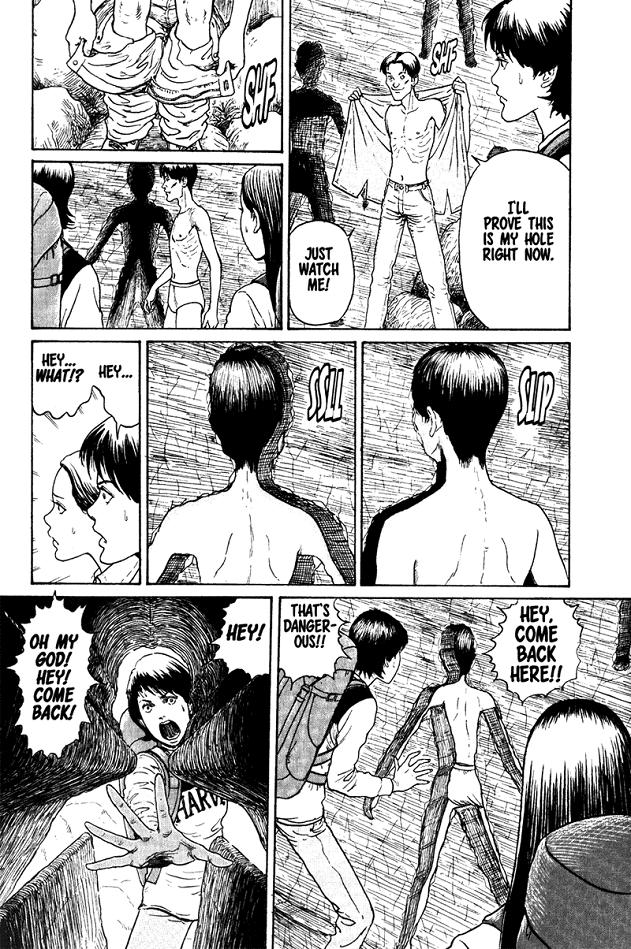
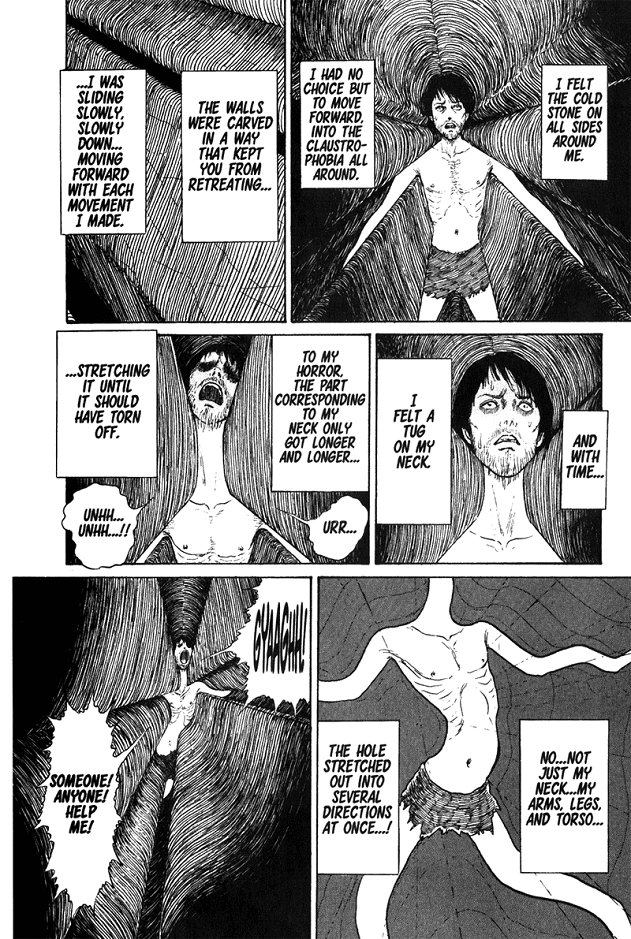
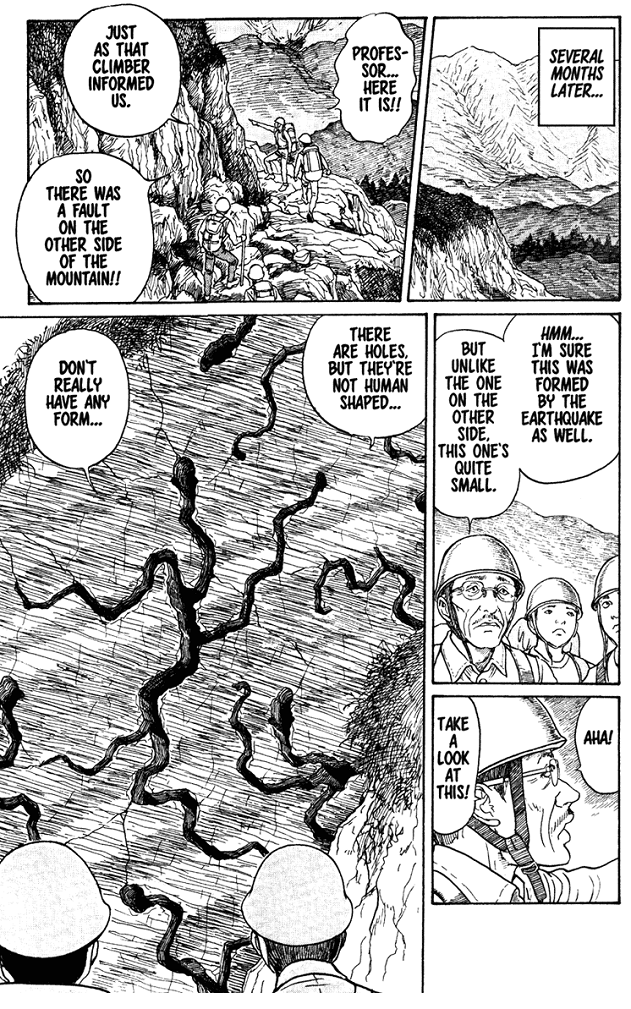
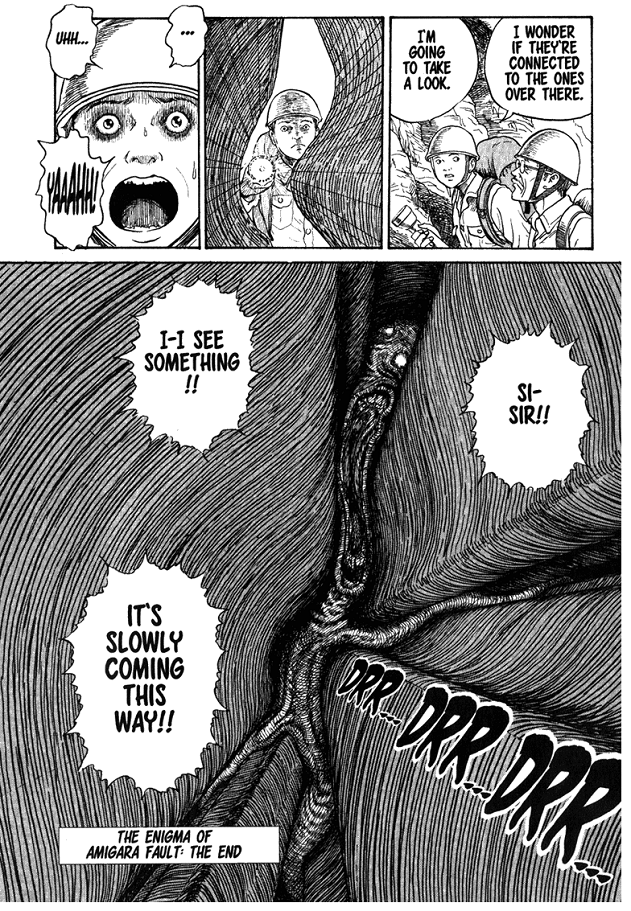



A few things come to mind:
1) Higurashi does these a lot, but my favorite for pure creepy sticks in the brain images is the end of the ‘Cotton Drifting’ Arc, where Keiichi, recovering in the hospital, sees a blood-covered ‘Mion’ crawling up his bed. It’s a pure horror image.
2) Kurosagi Corpse Delivery Service: the tank with the body full of ears.
Both of those sound very creepy! Again, it’s kind of the promise of a bad thing about to happen, or the mystery of “how/why did this happen?”
I’ve only read one volume of Kurosagi so far, and was fairly disturbed by some imagery therein, like to the point where I kept a blank piece of paper over a page so I wouldn’t accidentally glimpse it again when finding my place in the book. I did really like the characters, though, and have been meaning to get back to it.
Wow. I must be very difficult to creep out, at least visually, because I cannot think of any images from any comic which particularly creeps me out. I am much easier to spook with sounds. The only image I can think of from any work of art which really disturbs me out is a shot from the film “Come and See”. Two children were playing in a forest, and then came back to town. However, the boy’s mother was not at home, and there was nobody in town. The children are trying to figure out what happened to everybody, and the boy gets an idea. He thinks he knows where everybody is (someplace outside of town), and decides to run there there. The girls runs with him, but as she looks back at the town, she catches a glimpse of the pile of the murdered bodies of the townspeople. The very fact that we only get a very quick look – barely long enough to figure out that it *is* the bodies of the townspeople – makes it far creepier than if we had seen a very clear shot of the pile of bodies.
Maybe that says something about me – I’m not creeped out by what I can see, I’m creeped out by what I can’t see.
I get what you’re saying, and I think my creep threshold is similar. I can find an image gross but remain unaffected by it, but imagining something that has happened or is happening or will happen is what really gives me the jibblies!
I read this article yesterday, and last night trying to go to sleep, I could NOTget the pages from Amigara Fault out of my mind. (Thanks guys.) I think it is that aspect of losing all control over the situation and over yourself that bothers me the most about it. And that the people have seemingly done nothing to deserve being punished. I can’t read horror novels because they bother me too much, and I will not seek out a horror movie (though I will watch one with friends), but I do enjoy horror comics (Kurosagi being one of my favortes).
Oh dear. Sorry about that. And yes, loss of control is something that bothers me about it as well. Ito seems to like to write about mysterious forces that compel people to do strange things—that’s practically the entire plot of Uzumaki.
I wouldn’t say I can’t read a horror novel, but I generally don’t. Same with movies. I might go see Cabin in the Woods because it’s produced by Joss Whedon, but even then I am on the fence about it. My husband’s line is that he doesn’t want certain visuals in his head, and more and more I find myself in agreement with him.